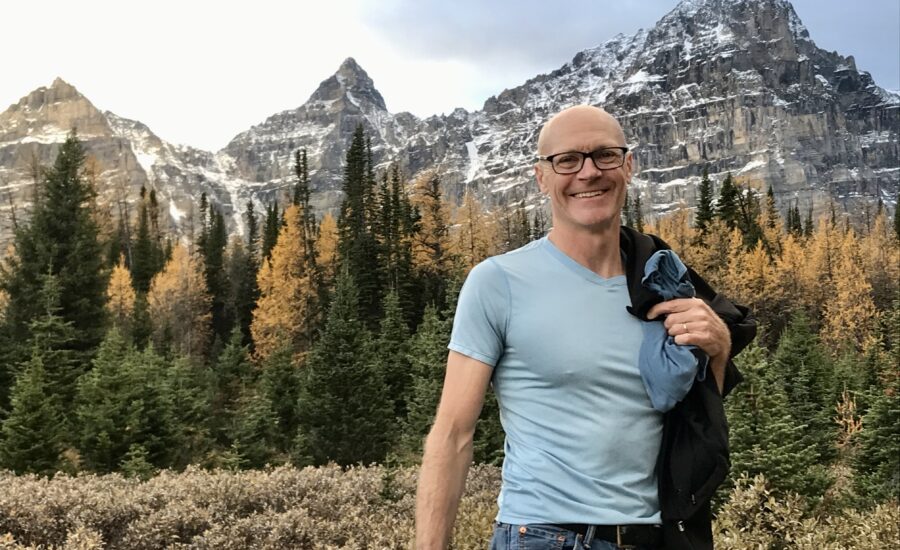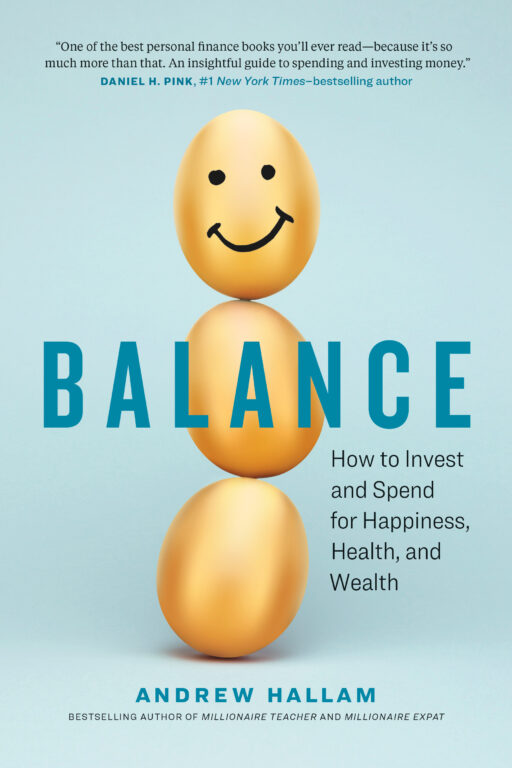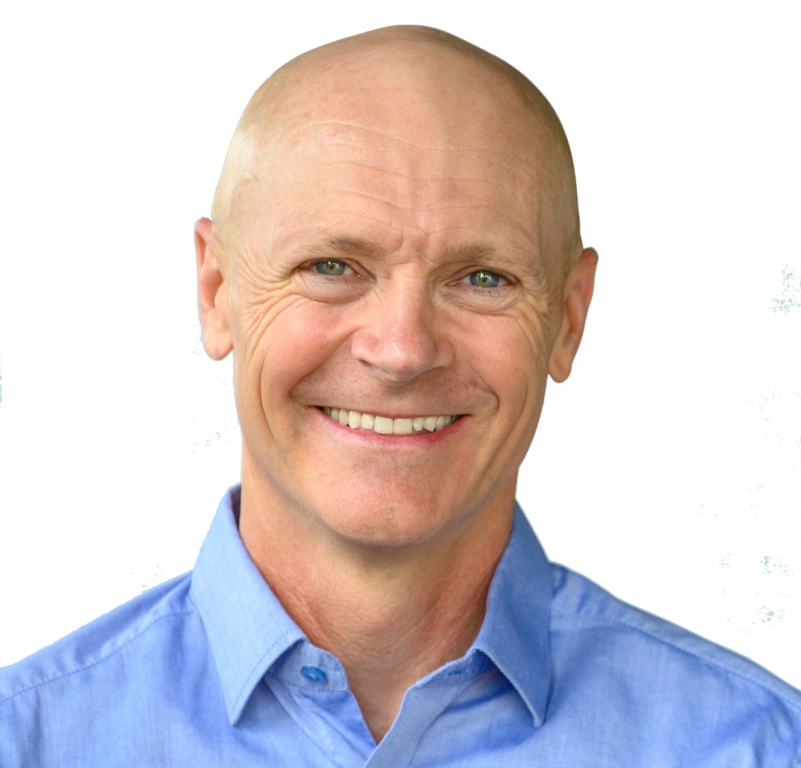Finding Balance: Q&A with author Andrew Hallam
The bestselling author of Millionaire Teacher and Millionaire Expat shares his blueprint for a successful and purposeful life.
Advertisement
The bestselling author of Millionaire Teacher and Millionaire Expat shares his blueprint for a successful and purposeful life.

Andrew Hallam’s story is the stuff of personal-finance legend. Through a combination of frugal living and prudent investing, he amassed a millionaire-dollar fortune by the age of 36, while working as a schoolteacher. In 2011, he published Millionaire Teacher: The Nine Rules of Wealth You Should Have Learned in School, a guide to achieving financial independence. A decade later, the book (updated in 2017) is still a go-to guide for financial literacy.
Today, Hallam is living what many of us would consider “the dream.” He and his wife, Pele, have been “globally nomadic” for eight years and counting, enjoying active adventures and occasionally popping back to Canada’s west coast to visit family. Hallam is now the author of four personal finance books, including his newest, Balance: How to Invest and Spend for Happiness, Health, and Wealth. I caught up with him in Panama City (virtually, that is) to talk about his enlightened guide to both money and life.

You’ve been thinking about life satisfaction for many years. In Balance, you explain that having money helps—up to a point. What’s the relationship between money and life satisfaction?
Economics professor Richard Easterlin did studies on life satisfaction relative to income. What he found was that if you don’t have enough money to feed yourself and have decent shelter, then money would increase life satisfaction. But once you have a little bit more than the national median, in any given country, there’s no increase in life satisfaction from more income. A Purdue-based study I referenced in the book found that beyond a certain point, life satisfaction actually drops. In North America, that point is about $160,000 a year.
The theory is that people who earn a lot of money, by and large, have high-responsibility jobs with high-stress commitments, so they drop the ball in other areas, like health, sleep or relationships. Often, we get tunnel vision. We start thinking that having more income and material things increases our lifestyle, but they don’t. There’s so much evidence suggesting that the best things in life are not things.
Besides having enough money, the other three pillars you list for a balanced and successful life are: maintaining strong relationships, maximizing our mental and physical health and living with a sense of purpose. You share lots of research that supports this holistic approach. Did anything surprise you?

What surprised me was one of the impetuses for writing this book. I was doing a lot of travelling and speaking engagements, and because of that I met people with such diverse, contrasting lifestyles: people with really high incomes, and people living simple lives in their RVs, working digitally, raising families. I remember thinking about where laughter was most prevalent. To be non-material seems very freeing. Those people seem to laugh more easily. They have a twinkle in their eye. They’re a lot less stressed.
We’ve become a highly materialistic culture, and that’s bad for the environment and bad for our pocketbooks. And when you meet these people who have turned their backs on that, who have decided they’re going to prioritize experiences, life, simplicity and relationships, there’s a freedom I noticed with those people. It made me realize that, wow, people don’t necessarily need as much money as they think they do.
“Stuff is like a short-term sugar rush, and then we’re left with the bill. But if we spend money on an experience, then we build memories.”
People often buy things because it makes them feel good. This effect doesn’t last, but we do it anyway. Why’s it so hard to opt out of the “culture of upgrades,” as you call it?
It’s a lack of awareness that material acquisitions don’t fulfill us. If you ask someone, “Why do you want to buy that?” they say, “I deserve it.” So, I ask, “Why do you deserve it?” If you continue to ask why, you’ll find that ultimately, everybody thinks these things will increase their life satisfaction. The irony is that all the research suggests it doesn’t enhance lifestyle at all. Most people who have more things are no happier than they were before they had them.
Recognizing that is such an important step. Once people do, they spend less. They’re able to invest more money for their future. They can spend on experiences instead of things. And they’re able to give more, in terms of charitable donations and helping others out. These are the things that enhance life satisfaction. Once people get that, it becomes a real turning point. But it’s hard to get that through to people because it’s not mainstream. We’re bombarded with advertisements. We’re surrounded by our neighbours who are purchasing things because they say they deserve it. It’s just never-ending.
In the book, you suggest this test to determine if a purchase is worth making: Ask yourself if it creates an experience you wouldn’t otherwise have.
It’s such a good way of assessing things. I’m not saying, “Don’t buy anything.” The point is to be super-honest with yourself. A lot of people don’t do a cost-benefit analysis. Let’s say it’s a vacation cabin—if it’s a big part of your life, and it brings people together, that’s awesome. Buy it if you’re really going to spend a lot of time there. But if you’re just going for two or three weeks a year, it’s a waste of money. In this case, it would be better to rent it instead.
During the pandemic, a lot of us have gotten pricey indulgences that we likely wouldn’t have bought were it not for lockdowns and social distancing. What do you make of these “pandemic purchases”?
We should make pandemic purchases that enhance experiences instead of just collecting stuff. Stuff is like a short-term sugar rush, and then we’re left with the bill. But if we spend money on an experience, then we build memories. Especially if an experience has an element of pro-social giving, where we’re giving to help somebody else out. That builds a memory that becomes part of our identity. We relive these things.
What will you spend your money on that you’re going to be talking about 10 years from now? It won’t be material pandemic purchases.
Investing is a big part of Balance. Over the past couple of years, thousands of Canadians have started investing, including new DIY (do-it-yourself) investors drawn to meme stocks and cryptocurrencies. What do you think of this trend, as someone who’s long advocated for simple, passive, long-term investing strategies?
We have peer-reviewed, irrefutably robust data on how to beat 90% of professional investors, and that is just with a diversified portfolio of ETFs—and not trading and not messing around. But a point of wild speculation occurs at least once every generation—we try to fast-track something.
I suggest not investing in those entities with money you can’t afford to lose. That doesn’t mean these investments won’t end up being profitable. They might or they might not, but they’re much more speculative. If you invest in a diversified portfolio of indexes, you’re buying shares of businesses, diversified companies that earn profits. As businesses increase their profits over time, share prices rise, businesses pay dividends and we can reinvest those dividends into more shares.
“We have peer-reviewed, irrefutably robust data on how to beat 90% of professional investors, and that is just with a diversified portfolio of ETFs.”
If you’re patient, this is something that’s virtually a long-term guarantee, or as close as we’re going to get to it. The other things are speculations. And if you want to improve, to give yourself the highest statistical odds of success, try to stay the course with a diversified portfolio of ETFs, rather than gambling with the next hot cryptocurrency or meme stock.
It’s become too easy to obsess over how our investment portfolios are doing, thanks to investing apps and websites. In Balance, you say that the better approach is to ignore the markets. Why is that, and how can investors chill out?
Simplifying your portfolio is a great first step. I love all-in-one portfolio ETFs because they make the process so simple. You don’t have to ask yourself, “Do I buy a U.S. stock ETF right now, a Canadian stock ETF, an international stock ETF or a bond ETF?” It’s all-in-one. You never have to know when to rebalance, because it rebalances automatically.
Robo-advisors are great, too. They cost a little more than an all-in-one ETF does, but you have far lower odds of doing something silly because there’s someone who’s able to talk you away from that edge before you make those speculative decisions.
Log into your account as infrequently as you can. I’m convinced that the less you look at your investment portfolio, the more money you’ll probably make.
You mention in the book that time is our only non-renewable resource. That struck a chord with me. The older I get, the faster time flies—especially during the pandemic, when each week blurs into the next. Have you felt the same?
Perception of time is one of my favourite subjects. For me, 2020 was one of the fastest years of my adult life. Because we all had to stay put, that year felt really accelerated.
We measure time based on alternative stimuli, which is what the research suggests. When we have fresh stimuli, time slows down. I’ve always had an appreciation for life, so I live like I know I’m going to die—I’m always looking for different stimuli.
To get that experience, we don’t necessarily need to travel. We can try something new, especially if it involves learning. If you take cooking classes, or you learn to play guitar, that slows down time, because you’ve created alternative fresh stimuli that you didn’t have before. It’s not necessary to go to an exotic place—you can see every day through a slightly different lens by giving yourself new experiences in that same spot.
For people who read this interview and are inspired to start prioritizing the other three pillars besides money, what advice can you share?
Set goals. When people want to achieve something, like running a marathon, they write it down. You write down a goal, and you get a training program. It’s a step-by-step process.
We realize relationships are important, but so few people set relationship goals. It’s something we need to do, probably before we set financial goals. The idea is to set relationship goals where we ask ourselves, “Over the next month, what do I plan to do with friends, with my family?” Write it down, then share it. Tell the people involved. Like with any goal, writing it down and sharing it creates accountability, especially if other people are included in the experience.
“Relationships are the single most important variable that leads to a life worth living.”
I find it helpful to write down what I’m going to do on any given day. As a freelancer, there’s not a lot of structure to my days, so I have to create it. I schedule times when I’ll be focusing on different things. And if there’s not a time slot where I’m going to do something pretty cool with my wife, then my priorities are totally backwards.
When we look at the Harvard Study of Adult Development, relationships are the single most important variable that leads to a life worth living, to a happy life. Of course, you have to have that balance—you can’t just party with your friends all the time. You need to have the different elements in the four pillars in your plan as well. Look at your finances and money, and how you’ll achieve those goals. But the relationship and health goals—we should write those down first.
This interview has been condensed and edited.
Share this article Share on Facebook Share on Twitter Share on Linkedin Share on Reddit Share on Email